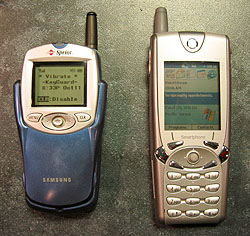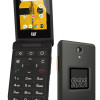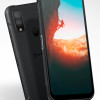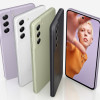Report from Redmond
As I mentioned earlier, Pocket PC Phone Edition is fairly straightforward. It's Microsoft's OS for handhelds with integrated wireless capability. The integration is fairly smooth, with everything linked where it should be. For example, some phones can automatically parse phone numbers out of SMS messages and provide links to call that number. Pocket PC Phone Edition also parses out and links e-mail addresses and web addresses throughout the OS.
The Pocket PC OS is based on Microsoft's Windows CE architecture. While a fundamentally different low-level architecture than the desktop versions of Windows, Windows CE platforms still have string ties to the desktop versions in several keys areas.
This gives Pocket PC its three main strengths: First, the interface is familiar. It's different, but only where necessary for the handheld paradigm. It's mostly intuitive, although there are a few inconsistencies. (Such as the fact that some items in the "menu bar" bring up menus, while others act like buttons, with no visible distinction between the two.)
Second, it's highly compatible. For example, you can simply drop a GIF, JPEG, or BMP image in a special folder on your desktop and connect a USB cable, and the image is automatically copied to your handheld via ActiveSync. A few taps on your handheld, and it's now your wallpaper. In Phone Edition, you can also do the same with WAV files for ringtones. Here are a couple good examples what you can do with WAV-format ringtones:
(Sound files no longer available)These are real Pocket PC Phone Edition ringtones, that are either included on the device, or are available as a free download. They sound about the same on the device as they probably do on your PC.
The third advantage is probably the least visible at the outset, but the most important overall. That is the developer community. Obviously, the general Windows developer community is gargantuan. Those developers can use the same tools and languages to build mobile applications that they currently use for desktop applications. Developer support is a crucial factor in the success of any major platform, and thanks to their Windows ties, Pocket PC and Smartphone both enjoy an advantage in this area from day one.
Closely related is the advantage in the corporate space. The vast majority of major corporations already have a siginificant investment in Microsoft technologies for both turnkey and custom corporate applications. Pocket PC integrates well with those Windows-based corporate systems. Microsoft has gone to great lengths to make it easy for corporations to extend their in-house systems to Pocket PC devices for mobile employees.
Enter Smartphone
So how is Windows Powered Smartphone different? The key difference is that Smartphone devices are designed to be phones first and foremost. The form factors (size and shape) will be much closer to that of regular high-end phones, and not much at all like typical handhelds or even the small phone/PDA combo devices.

Right: A quick size comparison. The pictured Smartphone (on the right) is a reference design co-developed by Microsoft and Texas Instruments, and manufactured by Compal.
Windows Powered Smartphones have traditional phone keypads, as opposed to a touch-screen and stylus. The devices are designed for one-handed operation, just like any cell phone. Text entry is via T9 predictive text. Instead of a menu bar and Start menu, navigation is designed around a required joystick and two softkeys. Smartphones also feature "home" and "back" buttons.
The displays, a crucial component, will be smaller than that of a Pocket PC, but higher resolution than most current high-end phones. The required display resolution for Smartphone is 176 by 220 pixels (color or greyscale).
Unfortunately, Smartphone does not include Microsoft's ClearType technology. (Pocket PC does.) ClearType is a text anti-aliasing (smoothing) technology optimized for LCD displays. I'm a big fan of ClearType - I use it on both my laptop and my Pocket PC Phone Edition, and I think it makes a significant difference. I think it would be especially useful on the small Smartphone displays (small relative to a laptop or handheld), but I guess the assumption is that most people won't be reading great lengths of text on a Smartphone, so they won't care if it doesn't look so great.
Another key difference will be price. Pocket PC devices are not known for being cheap - Smartphones supposedly will be. Microsoft doesn't actually design or manufacture these devices, but to help kick-start the market, they do have their own team of hardware engineers for Smartphone. In addition to speeding up hardware development, they have supposedly come up with some creative ways to produce these devices at some surprising price points.
So those are the main differences. However, I think the most compelling aspect of Smartphone is how similar it is to Pocket PC...
First of all, the processor architecture is the same. Many Pocket PCs use the ARM architecture. Smartphones also use standard ARM9 (or ARM7) processors. The first devices use OMAP processors from Texas Instruments, which integrate DSP functionality with an ARM9 processor. The OMAP processors are fast. We got a chance to see some live game demos on a Smartphone, and it was extremely impressive. 3D graphics and full-screen motion were no problem at all for the device. More about that later...
Second, the OS is virtually the same from the "inside" (for the developer). Most Pocket PC applications could actually be ported to Smartphone in less than a day. It's really just a matter of scaling down for the smaller display, and optimizing navigation for a joystick and soft keys, instead of a stylus. There is a very sizeable Pocket PC development community, and it will be exciting to see applications ported to Smartphone as the platform grows.
Also just like Pocket PC, there is a file system, and you can download and email all sorts of files and use them for things like ringtones and wallpaper, or view documents with viewer applications.
On the software side, Internet Explorer and Windows Media Player are included on both platforms. This version of Pocket Internet Explorer supports both HTML and Wireless Internet standards, such as WAP and i-Mode. There is also a Flash plug-in available, which I'll talk more about later...
Windows Media Player is particularly exciting, because it supports both audio and video, both local and streaming, and in a large array of formats. Streaming audio and video is obviously a very cool feature, but even downloaded multimedia becomes interesting when you consider that these devices have SD expansion slots. With the right compression and a big enough memory card, you could actually watch a full-length movie on one of these devices - there is no fixed limit to length of audio or video they will play. And yes - it plays MP3s - more about that later as well...


 Samsung Refreshes Galaxy S Series with S Pen, New Cameras
Samsung Refreshes Galaxy S Series with S Pen, New Cameras
 CAT Puts Android With Play Store in a Compact Flip Design
CAT Puts Android With Play Store in a Compact Flip Design
 Samsung Lets You Design Your Own Galaxy Z Flip3
Samsung Lets You Design Your Own Galaxy Z Flip3
 Kyocera Intros Slim, Rugged 5G Phone for Consumers
Kyocera Intros Slim, Rugged 5G Phone for Consumers
 Samsung Revives S21 Fan Edition
Samsung Revives S21 Fan Edition

